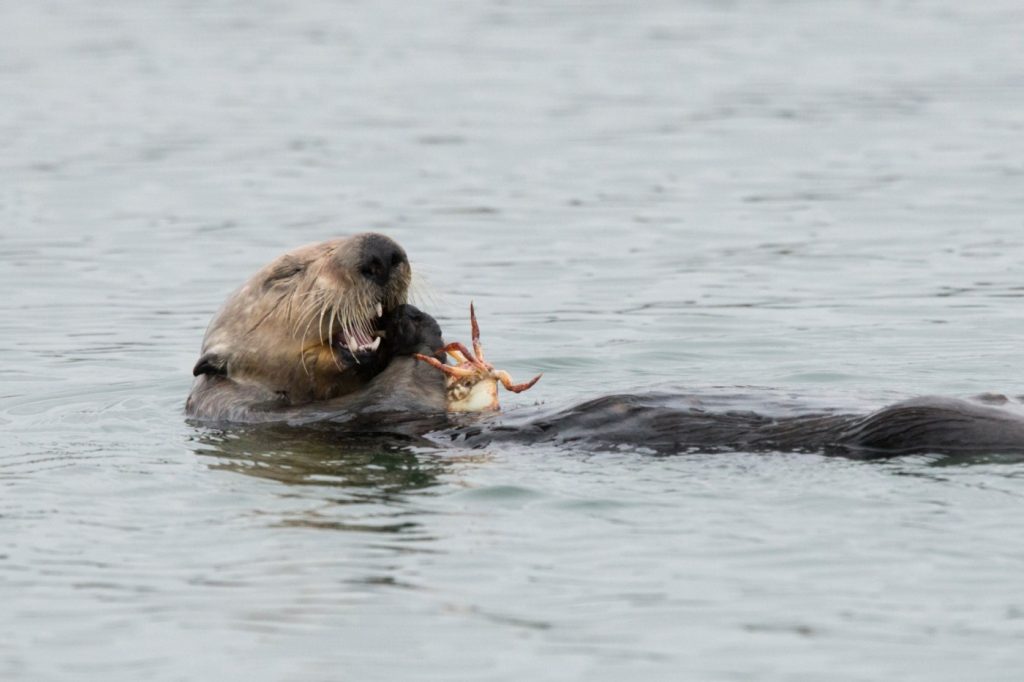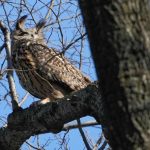Elkhorn Slough is a special place. Snaking 7 miles inland from Moss Landing, the protected tidal marshland encompasses over 4,200 acres of diverse ecosystems.
Mark Silberstein was living on a ranch on the banks of Elkhorn Slough back in the 1980s. During the winter, record-breaking El Niño storms rocked coastal communities around the world and sent sea otters swimming for cover.
Once hunted to the brink of extinction for their soft pelts, California sea otters were bouncing back thanks to thanks to measures like the Marine Mammal Protection Act of 1972 and the Endangered Species Act of 1973.
“A few otters took refuge in Elkhorn Slough,” Silberstein remembers, “and they discovered that it was like an open buffet.” They never left. In the 1980s, the Monterey Bay Aquarium started releasing rehabilitated sea otters into Elkhorn Slough. The population boomed. Today, it’s home to somewhere around 100 otters.
Southern Sea Otters, an endangered species, forage, rest and play at Moss Landing Harbor near Elkhorn Slough. (Photo by Kiliii Fish).
Elkhorn Slough’s resident otters were singled out when a team of scientists published a cover story in the prestigious journal Nature describing how they protect against erosion in coastal estuaries by eating burrowing crabs.
Silberstein, now director of the Elkhorn Slough Foundation, says this is a landmark study because it is really the first time that California Sea Otters have been studied in an estuarine setting, where freshwater streams meet the salty sea.
“Elkhorn Slough offered the opportunity to look at the interaction and the effect that otters have in this ecosystem,” he said.
The research paper sums up a project that unfolded over a decade in Monterey’s local living laboratory – Elkhorn Slough. Brent Hughes, a marine biologist at Sonoma State who previously studied at UC Santa Cruz and Moss Landing Marine Laboratory, led the study. Their findings show how reintroducing a top predator can improve the health and longevity of an ecosystem.
It’s important to take food webs and predator-prey dynamics into account when restoration work is done, says Hughes. “They’re going to do a lot of work that humans can’t,” or at least at a lower cost.
Elkhorn Slough’s resident sea otters safeguard creekbeds from crumbling. The marshy areas that flood at high tide are subject to erosion. Burrowing crabs weaken the soft, silty earth with their digging. Sea Otters, notorious eaters, keep the burrowing crab population in check and, thus, help stabilize the tidal marshes.
On a sunny day at low tide, sea otters languish on the grassy banks of estuary creekbeds, snacking. They eat burrowing crabs “like popcorn,” said Kathryn Beheshti, a UC Santa Barbara researcher involved in the study. “It’s really funny. They just pop the whole crab in their mouths.”
Beheshti got involved with the study in late 2012. She describes it as a “labor of love.” With an “army of undergrads” from UC Santa Cruz in tow, Beheshti woke up at 4 a.m. to make the pilgrimage to Elkhorn Slough every two weeks for five years during her Ph.D. They cleaned and collected data from 50 experimental plots, half of which were inhabited by sea otters.
“It was nonstop for many, many years,” and a lot of the work was “not so glamorous,” Beheshti recalls, like sorting through otter poop samples.
But their dedication paid off. By comparing tidal plots where otters were free to roam and feed with areas they were restricted from entering, the researchers established that the presence of sea otters reduced erosion rates by 69%.
“The thing with the sea otter,” said Hughes, “the way it behaves, it forages, the amount of food it eats. It just does remarkable things wherever it goes. California sea otters recently made headlines for their work revitalizing kelp forests off the Central Coast.
Hughes started studying the sea otters in Elkhorn Slough by accident. He’s a self-proclaimed plant enthusiast at heart. He found his way to the otters studying seagrass.
“At the time, I couldn’t care less about sea otters,” Hughes joked. He was studying seagrass in Elkhorn Slough because of its perplexing vitality. Despite years of pollution and algae blooms, it was bright, lush, and packed with nutrients. It “basically defied all theory.”
In his fruitless search for an explanation, Hughes met Yohn Gideon, captain of the Elkhorn Slough Safari. When Gideon took tourists on a boat through the slough, he equipped them with clickers to count sea otters. Thousands of trips later, Gideon had amassed a wealth of sea otter population data.
Most remarkably, the numbers matched up. As the sea otter community grew, the sea grass got healthier. Hughes investigated the link in a previous study published in 2013.
“When we were following the sea otters all around the estuary, we started noticing that they were using salt marshes,” said Hughes. This behavior was new to scientists. With food webs in mind, they suspected that the volume of crabs otters consumed might be significant. Over a decade later, data confirmed their suspicions.
“I think we’re in this really interesting time now where a lot of conservation efforts have been successful,” said Beheshti. Efforts to protect species like sea otters and gray wolves are now paying off. “We’re now able to sit back and watch how these ecosystems respond,” she added.
A southern sea otter rests and grooms in lower Elkhorn Slough. (Photo by Kiliii Fish)
Fanfare aside, Silberstein urges people to consider how careful stewardship made this study possible. “These things don’t happen in a vacuum.”


